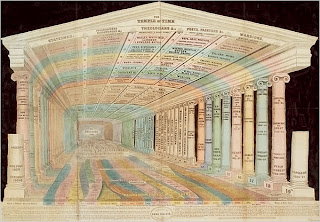Here is a book I´d like to have. From the New York Times -Books- I´ve downloaded the following paragraphs and pictures on the representation of time:
“Cartographies of Time,” published recently by Princeton Architectural Press, is an eye-popping record of the ways that mapmakers, chronologists, artists and others have tried to convey the passage of time visually.
This illustration from Lorenz Faust’s 1585 “Anatomia statuae Danielis” (Anatomy of Daniel’s statue), by an unknown artist, shows the rulers of the four great world monarchies on different parts of the armor, according to the historical scheme laid out by the biblical prophet Daniel. Each part of the statue’s body corresponds to a historical person or event. For example, Darius of Persia is located on the lung because Jews could breathe freely under his regime, while the sun-god-worshiping Roman emperor Heliogabalus, whose body was tossed into a sewer after he was deposed, is shown near “the exit from the rear.”
The 1840 “Catholic Ladder” was designed by a French Canadian Catholic priest named Francois Norbert Blanchet to teach basic Christian chronology and concepts to native peoples in the Pacific Northwest. The horizontal bars running up the middle represent the number of centuries since Creation, which is shown at the bottom using pictorial symbols for the sun, the stars and the earth. The detail at right shows the three crosses of Calvary and, above them, the founding of the Church.
The “Temple of Time,” created in 1846 by the pioneering American girls’ educator Emma Willard, draws on the tradition of Renaissance “memory theaters,” mnemonic devices that allowed people to memorize information by imagining it as architectural details in a three-dimensional mental space. The vertical columns represent centuries, with those on the right showing names of important figures from the Old World while those on the left show figures from the New World.
In her work “201 Days” (detail at left), the contemporary American artist Katie Lewis used pushpins to record the dates of everyday sensory events, whose synchronicities were then linked with thread. The result is an eerily abstracted portrait of her body over time. As Lewis has written, “My choice to use the body as a starting point aims to give visual form to physical sensations that are invisible to the eye and medical imaging, and only exist in the subjective realm.”





No comments:
Post a Comment